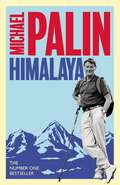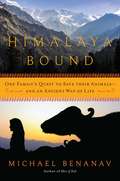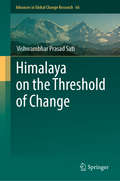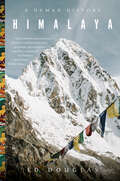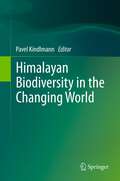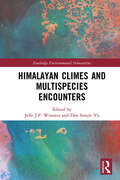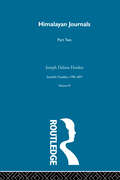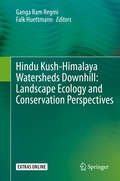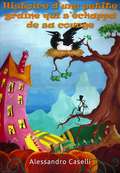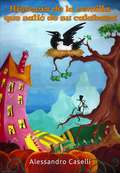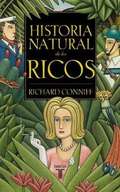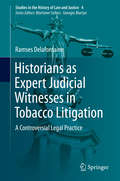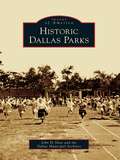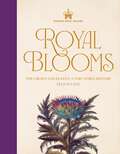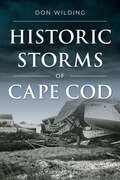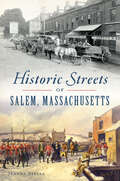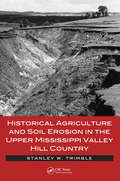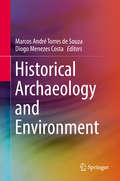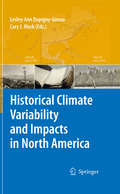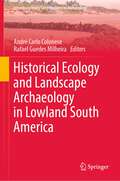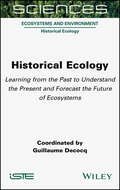- Table View
- List View
Hima Jour V1:Sci Tra 1790-1877
by Joseph Dalton HookerFirst published in 2003. Sir Joseph Hooker (1817-1911) was one of the greatest British botanists and explorers of the nineteenth century. He succeeded his father as Director of the Royal Botanic Gardens, Kew, and was a close friend and supporter of Charles Darwin. His journey to the Himalayas and India was undertaken between 1847 and 1851 to collect plants for Kew, and his account, published in 1854, was dedicated to Darwin. Hooker collected some 7,000 species in India and Nepal, and carried out surveys and made maps which proved of economic and military importance to the British. He makes many observations about the inhabitants of the areas he visited, making this volume a useful resource for anyone interested in nineteenth-century India.
Himalaya
by Michael PalinMichael Palin tackles the full length of the Himalaya in this terrific number one bestseller.Having risen to the challenge of seas, poles, dhows and deserts, the highest mountains in the world were a natural target for Michael Palin. In a journey rarely, if ever, attempted before, in 6 months of hard travelling Palin takes on the full length of the Himalaya including the Khyber Pass, the hidden valleys of the Hindu Kush, ancient cities like Peshawar and Lahore, the mighty peaks of K2, Annapurna and Everest, the gorges of the Yangtze, the tribal lands of the Indo-Burmese border and the vast Brahmaputra delta in Bangladesh.Facing altitudes as high as 17,500 feet as well as some of the world's deepest gorges, Palin also passed through political flashpoints like Pakistan's remote north-west frontier, terrorist-torn Kashmir and the mountains of Nagaland, only recently open to visitors.
Himalaya
by Michael PalinMichael Palin tackles the full length of the Himalaya in this terrific number one bestseller.Having risen to the challenge of seas, poles, dhows and deserts, the highest mountains in the world were a natural target for Michael Palin. In a journey rarely, if ever, attempted before, in 6 months of hard travelling Palin takes on the full length of the Himalaya including the Khyber Pass, the hidden valleys of the Hindu Kush, ancient cities like Peshawar and Lahore, the mighty peaks of K2, Annapurna and Everest, the gorges of the Yangtze, the tribal lands of the Indo-Burmese border and the vast Brahmaputra delta in Bangladesh.Facing altitudes as high as 17,500 feet as well as some of the world's deepest gorges, Palin also passed through political flashpoints like Pakistan's remote north-west frontier, terrorist-torn Kashmir and the mountains of Nagaland, only recently open to visitors.
Himalaya Bound: One Family's Quest To Save Their Animals--and An Ancient Way Of Life
by Michael BenanavA gorgeous work of literary journalism that follows a nomadic family’s fraught migration to the high Himalayan plains, as a changing world closes in around them. Following his vivid account of traveling with one of the last camel caravans on earth in Men of Salt, Michael Benanav now brings us along on a journey with a tribe of forest-dwelling nomads in India. Welcomed into a family of nomadic water buffalo herders, he joins them on their annual spring migration into the Himalayas. More than a glimpse into an endangered culture, this superb adventure explores the relationship between humankind and wild lands, and the dubious effect of environmental conservation on peoples whose lives are inseparably intertwined with the natural world. The migration Benanav embarked upon was plagued with problems, as government officials threatened to ban this nomadic family—and others in the Van Gujjar tribe—from the high alpine meadows where they had summered for centuries. Faced with the possibility that their beloved buffaloes would starve to death, and that their age-old way of life was doomed, the family charted a risky new course, which would culminating in an astonishing mountain rescue. And Benanav was arrested for documenting the story of their plight. Intimate and enthralling, Himalaya Bound paints a sublime picture of a rarely-seen world, revealing the hopes and fears, hardships and joys, of a people who wonder if there is still a place for them on this planet. Laced with stories of tribal cultures from India to Yellowstone, from Jordan to Kenya, Benanav deftly wends through the controversial terrain where Western ways of protecting the environment clash with indigenous understandings of nature. Himalaya Bound celebrates and mourns an ancient way of life, while revealing an unlikely battleground in the fight to save the earth.
Himalaya on the Threshold of Change (Advances in Global Change Research #66)
by Vishwambhar Prasad SatiThis book provides a unique and comprehensive assessment of the changes that have been taking place in the Himalayas. It describes in detail all the aspects of change, both natural and cultural, along with their implications, and suggests policy measures to help mitigate them. The book is divided into two major sections – on natural changes and cultural changes – and 11 chapters: an introduction, six addressing changes that concern natural aspects, and four exploring cultural changes and presenting the book’s conclusions. The content is based on a study conducted using a participatory observation/empirical method. Time series data from secondary sources is also included, helping to analyze the various changes. The findings are presented in the form of color graphs, models, maps, photographs, and tables. The book offers a valuable resource for policymakers, and will prove equally useful for all other stakeholders, e.g. researchers, students and development agents.
Himalaya: A Human History
by Ed DouglasA magisterial history of the Himalaya: an epic story of peoples, cultures, and adventures among the world’s highest mountains. For centuries, the unique and astonishing geography of the Himalaya has attracted those in search of spiritual and literal elevation: pilgrims, adventurers, and mountaineers seeking to test themselves among the world’s most spectacular and challenging peaks. But far from being wild and barren, the Himalaya has been home to a diversity of indigenous and local cultures, a crucible of world religions, a crossroads for trade, and a meeting point and conflict zone for empires past and present. In this landmark work, nearly two decades in the making, Ed Douglas makes a thrilling case for the Himalaya’s importance in global history and offers a soaring account of life at the "roof of the world." Spanning millennia, from the earliest inhabitants to the present conflicts over Tibet and Everest, Himalaya explores history, culture, climate, geography, and politics. Douglas profiles the great kings of Kathmandu and Nepal; he describes the architects who built the towering white Stupas that distinguish Himalayan architecture; and he traces the flourishing evolution of Hinduism, Islam, and Buddhism that brought Himalayan spirituality to the world. He also depicts with great drama the story of how the East India Company grappled for dominance with China’s emperors, how India fought Mao’s Communists, and how mass tourism and ecological transformation are obscuring the bloody legacy of the Cold War. Himalaya is history written on the grandest yet also the most human scale—encompassing geology and genetics, botany and art, and bursting with stories of courage and resourcefulness.
Himalayan Biodiversity in the Changing World
by Pavel KindlmannThis book presents some results on selected taxa in the Himalayan region (mainly Nepal), pinpoints the threats to their survival and suggests ways how to avoid their extinction. Most chapters are based on graduate research projects - relatively long-term field studies. The data presented here can be a good source of updated information on the subject and will prove to be a very useful reference in future studies of Himalayan biodiversity. They also tend to pinpoint the existing gaps in our knowledge of this region. All the chapters are based on recent trends of biodiversity and conservation vision, so the book can be a potential alternative to the existing relatively older books with outdated vision and information. Its main goal, however, is to disseminate the information about biodiversity conservation problems in the Himalayan region among the people in the developed world.
Himalayan Climes and Multispecies Encounters (ISSN)
by Dan Smyer Yü Jelle J.P. WoutersWoven together as a text of humanities-based environmental research outcomes, Himalayan Climes and Multispecies Encounters hosts a collection of historical and fieldwork-based case studies and conceptual discussions of climate change in the greater Himalayan region.The collective endeavour of the book is expressed in what the editors characterize as the clime studies of the Himalayan multispecies worlds. Synonymous with place embodied with weather patterns and environmental history, clime is understood as both a recipient of and a contributor to climate change over time. Supported by empirical and historical findings, the chapters showcase climate change as clime change that concurrently entails multispecies encounters, multifaceted cultural processes, and ecologically specific environmental changes in the more-than-human worlds of the Himalayas.As the case studies complement, enrich, and converse with natural scientific understandings of Himalayan climate change, this book offers students, academics, and the interested public fresh approaches to the interdisciplinary field of climate studies and policy debates on climate change and sustainable development.
Himalayan Journals, Volume II: Scientific Travellers 1790-1877 Volume 2
by Joseph Dalton HookerThis is Volume II of the Himalayan Journals or the notes of a naturalist travelling in Bengal, The Sikkim and Nepal Himalayas, the Khasia Mountains.
Hindu Kush-Himalaya Watersheds Downhill: Landscape Ecology and Conservation Perspectives
by Falk Huettmann Ganga Ram RegmiThis book describes the myriad components of the Hindu Kush-Himalaya (HKH) region. The contributors elaborate on challenges, failures, and successes in efforts to conserve the HKH, its indigenous plants and animals, and the watershed that runs from the very roof of the planet via world-rivers to marine estuaries, supporting a human population of some two billion people. Readers will learn how the landforms, animal species and humans of this globally fascinating region are connected, and understand why runoff from snow and ice in the world’s tallest mountains is vital to inhabitants far downstream. The book comprises forty-five chapters organized in five parts. The first section, Landscapes, introduces the mountainous watersheds of the HKH, its weather systems, forests, and the 18 major rivers whose headwaters are here. The second part explores concepts, cultures, and religions, including ethnobiology and indigenous regimes, two thousand years of religious tradition, and the history of scientific and research expeditions. Part Three discusses policy, wildlife conservation management, habitat and biodiversity data, as well as the interaction of animals and humans. The fourth part examines the consequences of development and globalization, from hydrodams, to roads and railroads, to poaching and illegal wildlife trade. This section includes studies of animal species including river dolphins, woodpeckers and hornbills, langurs, snow leopards and more. The concluding section offers perspectives and templates for conservation, sustainability and stability in the HKH, including citizen-science projects and a future challenged by climate change, growing human population, and global conservation decay. A large assemblage of field and landscape photos, combined with eye-witness accounts, presents a 50-year local and wider perspective on the HKH. Also included are advanced digital topics: data sharing, open access, metadata, web portal databases, geographic information systems (GIS) software and machine learning, and data mining concepts all relevant to a modern scientific understanding and sustainable management of the Hindu Kush-Himalaya region. This work is written for scholars, landscape ecologists, naturalists and researchers alike, and it can be especially well-suited for those readers who want to learn in a more holistic fashion about the latest conservation issues.
His Indian Brother
by Hazel WilsonIn the early 1800's, Brad Porter and his father have traveled from boston to the Maine woods to build a cabin for the Porter family. Brad stays to continue preparing the cabin while his father goes back to bring Ma and the twin girls to their new home. But the time for returning passes and brad finds himself alone and in trouble, due to some mishaps such as a bear that eats most of the food, losing his father's rifle, and a broken ankle. He is in danger of starving when some Indians rescue him. One is chief kineowa, and the other is a boy around brad's age, sabattis. When the chief goes to join his tribe, Sabattis stays behind to care for Brad. Still grieving for his family, brad nevertheless finds it exciting to learn to hunt and fish as well as sabattis, whose somewhat contemptuous attitude changes gradually to friendship and respect as the boys share experiences, joys and dangers. Brad and sabattis come to regard themselves as brothers, yet Brad's lost family is still in his heart. Can he become an adopted member of sabattis's tribe, or will something happen to change his plans for a new life with his indian brother? This is a fine book for children, based on the same source material as The Sign of the Beaver, but in my opinion more engaging.
Histoire d’une petite graine qui s’échappa de sa courge
by Alessandro CaselliNut est une graine qui mène, avec tous ses frères et sœurs, une vie protégée et tranquille dans « sa » courge. Mais contrairement aux autres, il est convaincu qu’il existe un « Monde extérieur ». Bien que tout le monde le lui déconseille, Nut décide de surmonter sa peur et de sortir pour voir ce qui l’attend dehors. Une fourmi, une cigale et une pie lui feront découvrir le monde qu’elles connaissent depuis longtemps. Mais, et s’il ne s’agissait encore que d’une autre courge de laquelle il lui faudrait chercher à sortir ?
Historia de una semilla que salió de su calabaza
by Alessandro CaselliNut es una semilla que vive, junto con sus hermanos, una vida segura y tranquila dentro de “su” calabaza, pero a diferencia de ellos está convencido de la existencia de un “Mundo Allá-Afuera”. Aunque todos lo aconsejan de no seguir esos sueños, Nut decide superar el miedo y salir para ver qué le espera allá afuera. Una hormiga, una cigarra y una urraca lo llevarán a descubrir el mundo que ellos conocen ya desde hace tiempo. ¿Pero que se trate de nuevo de otra calabaza de la que se debe buscar la salida?
Historia natural de los ricos
by Richard ConniffRichard Conniff indaga acerca de si la vieja pregunta ¿son los ricos diferentes del resto de la gente? es cierta y concluye que, efectivamente, son unos animales completamente distintos. Observa con mucho sentido del humor esta especie social única, develando sus estrategias de dominación y sumisión, su comportamiento exhibicionista, sus intrincados mecanismos jerárquicos, así como sus poco ortodoxas prácticas de apareamiento. Comparándola con otras especies exóticas, Conniff descubre sorprendentes coincidencias. ¿En qué medida la aduladora actitud de los ricos se parece a la de los babuinos? ¿Cómo logró la aristocracia británica convertirse en la jerarquía animal más perfecta del planeta? ¿Por qué el aislamiento acaba haciendo de los ricos una subespecie? Un cautivador y desternillante análisis sobre la idiosincrásica existencia de los muy ricos, a través de la aguda lente de un naturalista. "Richard Conniff es un escritor espléndido, lleno de frescura, claridad y ninguna condescendencia." The New York Times Book Review
Historians as Expert Judicial Witnesses in Tobacco Litigation
by Ramses DelafontaineHistorian Ramses Delafontaine presents an engaging examination of a controversial legal practice: the historian as an expert judicial witness. This book focuses on tobacco litigation in the U. S. wherein 50 historians have witnessed in 314 court cases from 1986 to 2014. The author examines the use of historical arguments in court and investigates how a legal context influences historical narratives and discourse in forensic history. Delafontaine asserts that the courtroom is a performative and fact-making theatre. Nonetheless, he argues that the civic responsibility of the historian should not end at the threshold of the courtroom where history and truth hang in the balance. The book is divided into three parts featuring an impressive range of European and American case studies. The first part provides a theoretical framework on the issues which arise when history and law interact. The second part gives a comparative overview of European and American examples of forensic history. This part also reviews U. S. legal rules and case law on expert evidence, as well as extralegal challenges historians face as experts. The third part covers a series of tobacco-related trials. With remunerations as high as hundreds of thousands of dollars and no peer-reviewed publications or communication on the part of the historians hired by the tobacco companies the question arises whether some historians are willing to trade their reputation and that of their university for the benefit of an interested party. The book further provides 50 expert profiles of the historians active in tobacco litigation, lists detailing the manner of the expert's involvement, and West Law references to these cases. This book offers profound and thought-provoking insights on the post-war forensification of history from an interdisciplinary perspective. In this way, Delafontaine makes a stirring call for debate on the contemporary engagement of historians as expert judicial witnesses in U. S. tobacco litigation.
Historic Dallas Parks
by Dallas Municipal Archives John H. SlateDallas, called "Big D," is the eighth largest city in the United States and rests on 343 square miles of rolling prairie. To meet the growing recreational and cultural needs of its citizens, the Dallas Park and Recreation Department maintains more than 23,018 park acres--one of the largest municipal park systems in the country. Dallas has over 400 individual parks, including community centers, swimming pools, athletic fields, and a metropolitan zoo. From such well-known places as Fair Park, home of the State Fair of Texas and the Texas Centennial Exposition of 1936, to Dealey Plaza, and to lesser-known neighborhood parks, Dallas parks have a rich history stretching from the days when Dallas was a western boom town to a 21st century metropolis. Historic Dallas Parks explores the origins and early development of this nationally recognized system with interesting background stories and facts and illustrated with photographs and historical documents from the collections of the Dallas Municipal Archives.
Historic Royal Palaces: The Crown and Plants: A Very Noble History (Historic Royal Palaces)
by Felicity DayHistoric Royal Palaces: Royal Blooms is a fascinating exploration of how plants and flowers have formed an integral part of the crown, from the past through to present day. From mulberry and myrtle to pomegranate and poppy, this beautifully illustrated and expertly written book depicts in detail how plants and flowers have been used by various royals throughout the centuries not just for power, politics and status but more recently, celebration. This four-colour beautiful, upmarket gift book is filled with interesting facts and captivating stories alongside stunning botanical illustrations and historical photographs from the Historic Royal Palaces archive, all focused on the crown's fascination with plants and flowers, from the war of the roses to royal wedding bouquets and everything in between.
Historic Royal Palaces: The Crown and Plants: A Very Noble History (Historic Royal Palaces)
by Felicity DayHistoric Royal Palaces: Royal Blooms is a fascinating exploration of how plants and flowers have formed an integral part of the crown, from the past through to present day. From mulberry and myrtle to pomegranate and poppy, this beautifully illustrated and expertly written book depicts in detail how plants and flowers have been used by various royals throughout the centuries not just for power, politics and status but more recently, celebration. This four-colour beautiful, upmarket gift book is filled with interesting facts and captivating stories alongside stunning botanical illustrations and historical photographs from the Historic Royal Palaces archive, all focused on the crown's fascination with plants and flowers, from the war of the roses to royal wedding bouquets and everything in between.
Historic Storms of Cape Cod (Disaster)
by Don WildingCape Cod has always been in the path of deadly hurricanes and ferocious storms. Unwelcome summer visitors include the "Long Island Express" Hurricane of 1938, the Great Atlantic Hurricane of 1944, the twin Hurricanes Carol and Edna in 1954, and Hurricane Bob in 1991. These storms destroyed countless homes and left several coastal communities under several feet of water. Surging tides carried away houses with residents inside who didn't survive and sank the Coast Guard lightship Vineyard in Buzzards Bay, killing all 12 crew members. Fall and winter brought the benchmark Blizzard of 1978, the nor'easter of January 1987, and the infamous "Perfect Storm" of October 1991 which delivered some of the highest tides ever seen on the Outer Cape. Local author Don Wilding revisits the Cape's most severe weather events and their devastating impact.
Historic Streets of Salem, Massachusetts (American Chronicles)
by Jeanne StellaWith this informative and easy-to-use guide, the streets of Salem come alive with history at every turn. When most people think of Salem, they think of witchcraft, Nathaniel Hawthorne, and Samuel McIntire. But there is far more to this coastal city&’s rich history. Echoes of lesser-known tales linger along its lanes and avenues, from the mysteries of Chestnut Street to the founding Quakers of Buffum Street. Local historian Jeanne Stella recounts the stories behind some of Salem&’s oldest street names and reveals the hidden histories that reside within. With her colorful and fascinating tales, you can step back in time as you walk down Daniels Street, learn the many firsts that happened on Broad Street, and discover the varied uses of Salem Common.
Historical Agriculture and Soil Erosion in the Upper Mississippi Valley Hill Country
by Stanley W. Trimble"This thought-provoking book demonstrates how processes of landscape transformation, usually illustrated only in simplified or idealized form, play out over time in real, complex landscapes. Trimble illustrates how a simple landscape disturbance, generated in this case by agriculture, can spread an astonishing variety of altered hydrologic and sedi
Historical Archaeology and Environment
by Marcos André Souza Diogo Menezes CostaThis edited volume gathers contributions focused on understanding the environment through the lens of Historical Archaeology. Pressing issues such as climate change, global warming, the Anthropocene and loss of biodiversity have pushed scholars from different areas to examine issues related to the causes, processes, and consequences of these phenomena. While traditional barriers between natural and social sciences have been torn down, these issues have gradually occupied a central place in the field of anthropology. As archaeology involves the transdisciplinary study of cultural and natural evidence related to the past, it is in a privileged position to discuss the historical depth of some of the processes related to environment that are deeply affecting the world today. This volume brings together substantial and comprehensive contributions to the understanding of the environment in a historical perspective along three lines of inquiry: Theoretical and methodological approaches to the environment in Historical Archaeology Studies on environmental Historical Archaeology Historical Archaeology and the Anthropocene Historical Archaeology and Environment will be of interest to researchers in both social and environmental sciences, working in different disciplines and research areas, such as archaeology, history, geography, anthropology, climate change studies, environmental analysis and sustainable development studies.
Historical Climate Variability and Impacts in North America
by Cary J. Mock Lesley-Ann Dupigny-GirouxClimatologists with an eye on the past have any number of sources for their work, from personal diaries to weather station reports. Piecing together the trajectory of a weather event can thus be a painstaking process taking years and involving real detective work. Missing pieces of a climate puzzle can come from very far afield, often in unlikely places. In this book, a series of case studies examine specific regions across North America, using instrumental and documentary data from the 17th to the 19th centuries. Extreme weather events such as the Sitka hurricane of 1880 are recounted in detail, while the chapters also cover more widespread phenomena such as the collapse of the Low Country rice culture. The book also looks at the role of weather station histories in complementing the instrumental record, and sets out the methods that involve early instrumental and documentary climate data. Finally, the book's focus on North America reflects the fact that the historical climate community there has only grown relatively recently. Up to now, most such studies have focused on Europe and Asia. The four sections begin with regional case studies, and move on to reconstruct extreme events and parameters. This is followed by the role of station history and, lastly, methodologies and other analyses. The editors' aim has been to produce a volume that would be instrumental in molding the next generation of historical climatologists. They designed this book for use by general researchers as well as in upper-level undergraduate or graduate level courses.
Historical Ecology and Landscape Archaeology in Lowland South America (Interdisciplinary Contributions to Archaeology)
by André Carlo Colonese Rafael Guedes MilheiraThis edited volume scrutinizes how pre-Columbian human societies have shaped and transformed lowland South America – contributing to biological and landscape diversity. This geographic area has supported human populations since at least the transition from the Pleistocene to Holocene, but the nature and scale of these interactions are matters of debate and their legacy to modern lowland environments is not fully understood. This book brings together works from distinct disciplines, including theoretical and methodological approaches on single case studies or broad regional syntheses, with no chronological constraint. The editors aim to generate a novel contribution reporting the most recent and ground-breaking research on human interactions with past environments and resources in lowland South America, from pre-Columbian to Colonial times. The volume also discusses the legacy of these past interactions and their potential contribution to informing current conservation and development agendas, providing examples of how archaeology and paleoecology can fill gaps in conservation and developmental policy. This volume will be of interest to students, archaeologists, and readers of Latin American studies.
Historical Ecology: Learning from the Past to Understand the Present and Forecast the Future of Ecosystems
by Guillaume DecocqThis book addresses present-day landscapes, ecosystem functioning and biodiversity as legacies of the past. It implements an interdisciplinary approach to understand how natural or human-impacted ecological systems have changed over time.Historical Ecology combines theory, methods, regional case studies and syntheses to provide a complete up-to-date overview of historical ecology. Beginning with the crucial role of time and inference from observed patterns, the book critically reviews the main methodological approaches, including monitoring of permanent plots, analysis of old maps, repeat photography, remote sensing, soil analysis, charcoal analysis, botanical indicators, and combinations of these methods applied to forest ecosystems.A series of case studies from various biomes shows how historical ecology can help in understanding today&’s socio-ecosystems, such as mainland and island forests, orchards, tundra and coastal dunes. The book concludes by showing how historical ecology can answer timely fundamental research questions and provide science-based evidence for landscape and ecosystem management.

